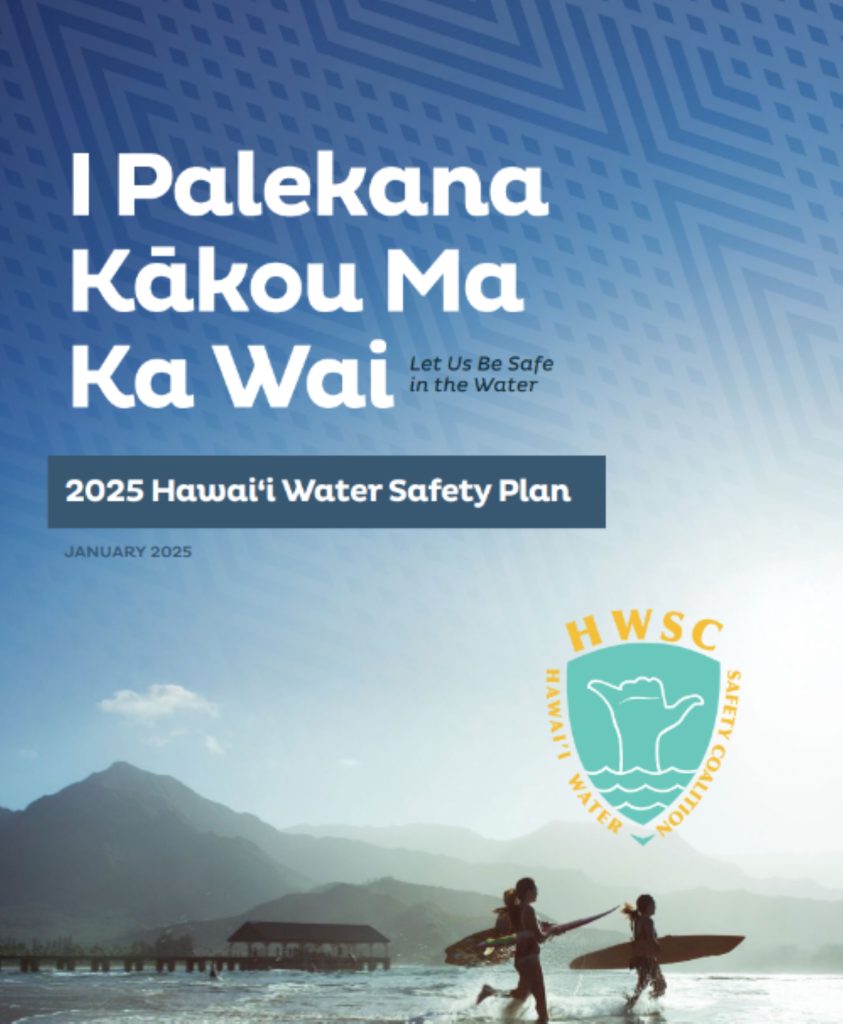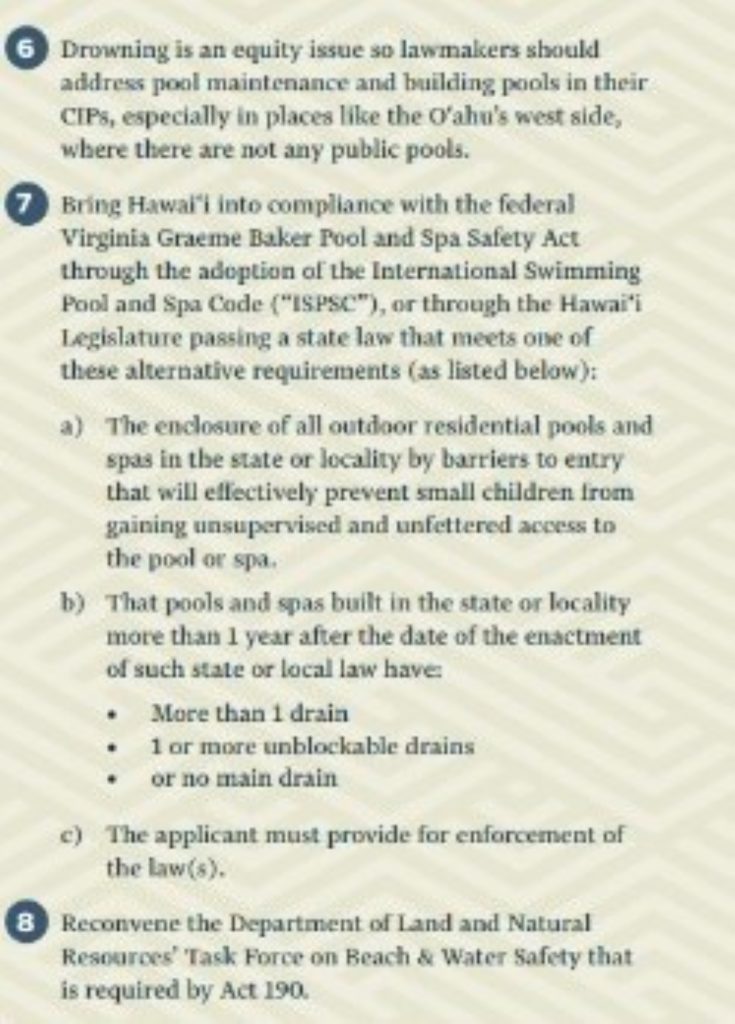Coalition releases first Hawaiʻi Water Safety Plan aimed at addressing state’s drowning crisis
The Hawaiʻi Water Safety Coalition recently released the first Hawaiʻi Water Safety Plan aimed at addressing a drowning crisis in the islands that threatens the health of residents and visitor-dependent economy.
Under the umbrella of the Hawaiian Lifeguard Association, coalition members called on water safety stakeholders throughout the islands to identify the state’s most urgent drowning prevention needs.

“I Palekana Kākou Ka Wai: Let Us Be Safe in the Water” is a roadmap to counter Hawaiʻi’s drowning crisis by ensuring everyone is safe on, in and around the water.
“Sadly, drowning remains the leading cause of injury-related death for visitors in our state,” said Hawaiian Lifeguard Association President Kalani Vierra. “Moreover, it’s heartbreaking to know that for our local youth aged 1 to 15, drowning is the foremost cause of death.”
Data in the plan also reveal that those who are most connected to Native Hawaiian and Pacific Islander heritages are drowning in higher numbers.
Key statistics from the Hawaiʻi Water Safety Plan include:
- Drowning is the No. 1 cause of death for children ages 1–15 in the islands.
- Hawaiʻi’s resident drowning rate is the second highest in the nation, only behind Alaska.
- Native Hawaiians and Pacific Islanders are about 27% of Hawai’i s population yet make up 36% of resident drowning deaths.
- Less than 2% of Hawaiʻi’s second-graders have the basic skills to avoid or recover from drowning.
- Drowning is the leading cause of injury-related death for visitors.
Hawai‘i is only the second state to produce its own water safety plan after the 2023 U.S. National Water Safety Action Plan challenged all 50 states to create plans specific to their needs.


“The ocean and our waterways are not just resources; they are part of our home and our lives,” said Vierra. “It is our collective responsibility, our kuleana, to protect our cherished waters and to raise awareness about the hidden dangers they may hold.”
Unfortunately, several young children drown each year in Hawai‘i. Many more are seen in emergency departments throughout the state.
“Some kids even suffer long-term health effects such as brain damage,” said Dr. Pat Morgan, medical director of Kapiʻolani Child Advocacy and Protection Center at the Kapiʻolani Medical Center for Women and Children in Honolulu.
Morgan is also a member of the Hawai‘i Child Death Review System team.
Established in 1997 by the Hawai‘i Legislature, the Child Death Review team is tasked with conducting comprehensive and multidisciplinary reviews of deaths of keiki up to 17 years old to understand risk factors of child deaths.
“Drownings are preventable with constant adult supervision in and around the water, including at home,” said Morgan. “Toddlers are especially at risk, as are children with other health conditions, including autism. Our goal is to protect children from drowning in Hawai‘i.”
Big Island state Rep. Jeanné Kapela and Hawai’i Senate Majority Floor Leader Sen. Glenn Wakai of O‘ahu introduced a package of bills this legislative session inspired by recommendations in the Hawai‘i Water Safety Plan.
“In Hawaiʻi, we are surrounded by the beautiful ocean, and it should be a straightforward decision to incorporate water safety into our curriculum, starting in our schools,” said Kapela. “A water safety education program equips our keiki with the knowledge and skills they need to stay safe in and around the water, while minimizing risk in our communities.”

House Bill 1234 and Senate Bill 1223 would require and appropriates funds for the Hawai‘i Department of Education to establish a standards-based Water Safety Education Pilot Program.
HB 1234 passed first reading and was referred to the House committees on Education and Finance.
Kapela and Kaua‘i state Rep. Luke Evslin are members of the Education Committee. Big Island state Reps. Sue Keohokapu-Lee Loy and Matthias Kusch as well as Kaua‘i state Rep. Dee Morikawa are members of the Finance Committee.
SB 1223 passed first reading and was referred to the Senate committees on Education and Ways and Means.
Big Island state Sens. Lorraine Inouye and Senate Majority Leader Sen. Dru Kanuha are members of the Ways and Means Committee. Kanuha also is a member of the Education Committee.
The HWSC’s other legislative priorities include:
House Bill 1233 and Senate Bill 1222
- The bills call for the establishment of basic safety requirements for construction of new retention and detention ponds, such as requiring signage, fencing and life buoy flotation devices to help buy time if someone is struggling in the pond. They also would require a statewide survey of existing retention and detention ponds.
- HB 1233 status: Passed second reading, as amended, and referred to the House Committee on Health. The measure is scheduled to be heard by the Health Committee at 10 a.m. Feb. 12. Keohokapu-Lee Loy is vice chairwoman of the committee.
- SB 1222 status: Deferred by the Senate committees on Energy and Intergovernmental Affairs and Health and Human Services. Big Island state Sen. Tim Richards is a member of the Energy and Intergovernmental Affairs Committee. Big Island state Sen. Joy San Buenaventura is a member and chairwoman of the Health and Human Services Committee.
House Bill 1232 and Senate Bill 1221
- These measures also would establish certain safety requirements for construction of new retention and detention ponds. They would also appropriate funds to create a statewide inspection and monitoring program. Golf courses, hotels, resort properties or other secured recreational areas would be exempt as long as they provide security for their detention and retention ponds.
- HB 1232 status: Passed first reading and referred to the House committees on Water and Land, Judiciary and Hawaiian Affairs and Finance. Morikawa as well as Big Island state Reps. David Tarnas, Kirstin Kahaloa and House Majority Caucus Leader Chris Todd sit on the Judiciary and Hawaiian Affairs Committee. Tarnas is the committee chairman.
- SB 1221 status: The Senate committees on Energy and Intergovernmental Affairs and Health and Human Services each recommended SB 1221 be passed, with amendments.
“As we continue to face the challenges of our changing climate and growing populations, it is our duty to strengthen water safety measures, especially for our children here in Hawaiʻi,” said Wakai. “Our intention of introducing these bills is to safeguard our communities’ health, prevent tragic accidents and ensure that every family has peace of mind knowing their loved ones are safe in and around water.”
Hawai‘i Gov. Josh Green last year signed two Hawaiʻi Water Safety Coalition-initiated bills into law.
One measure designated May 15 each year as Water Safety Day in Hawai‘i was propelled by lives lost to drowning.
The other bill honored legendary waterman Duke Kahanamoku’s enduring legacy by authorizing the issuance of special license plates commemorating his life. Funds raised by the issuance of the plates support water safety programs.
“Together, we can work to ensure a safer experience for everyone who enjoys the beauty of Hawai‘i,” Vierra said. “We sincerely hope that the Hawaiʻi Water Safety Action Plan will make a meaningful impact in reducing the tragic incidents of drowning and preventing aquatic injuries across our islands.”
Sponsored Content
Comments














